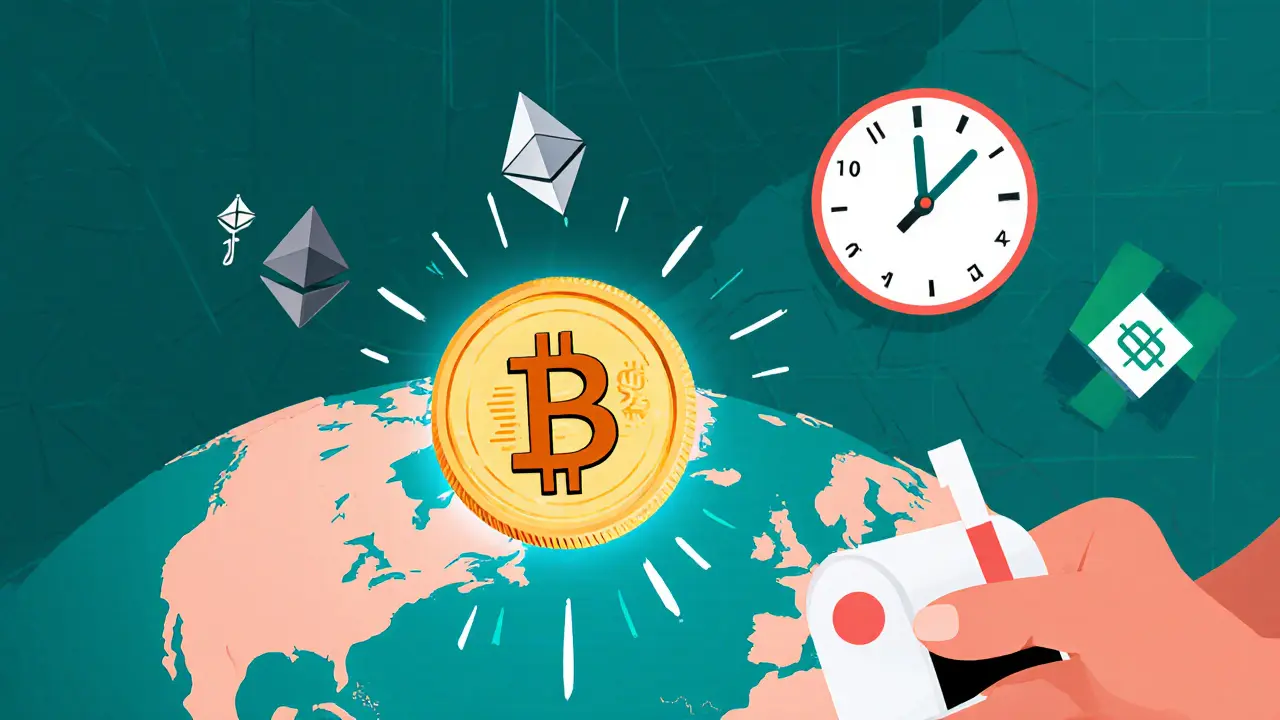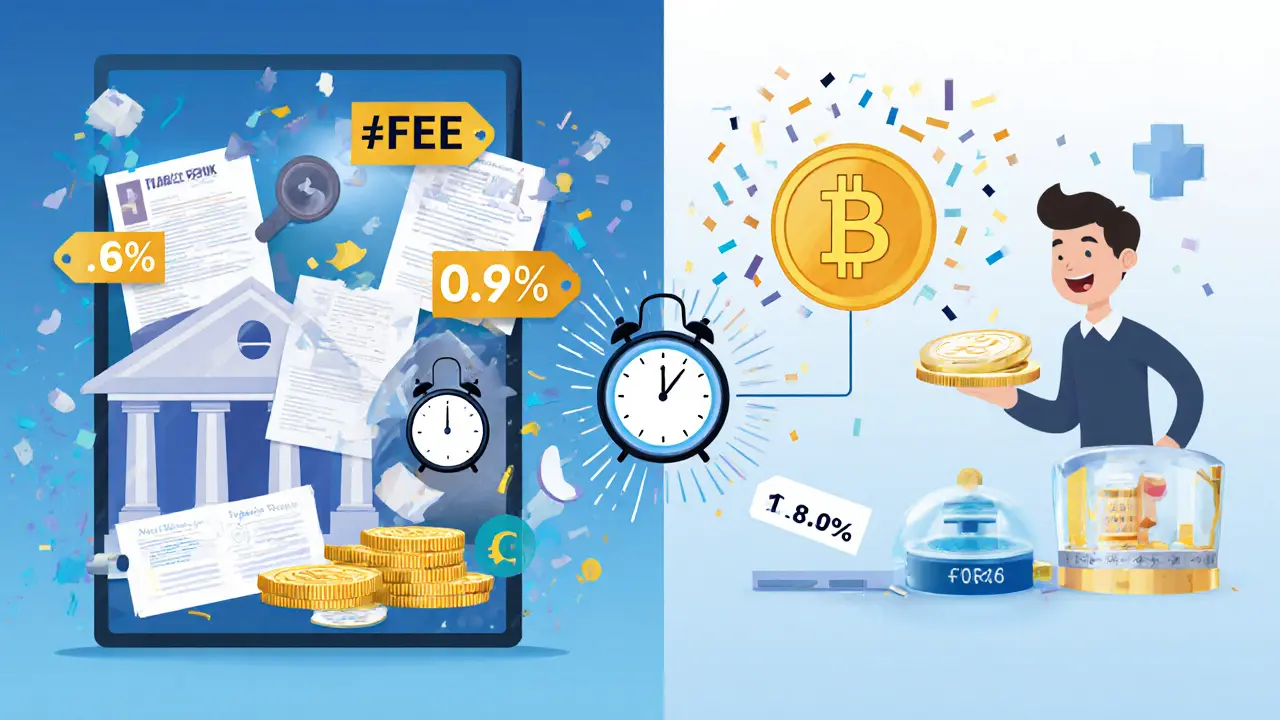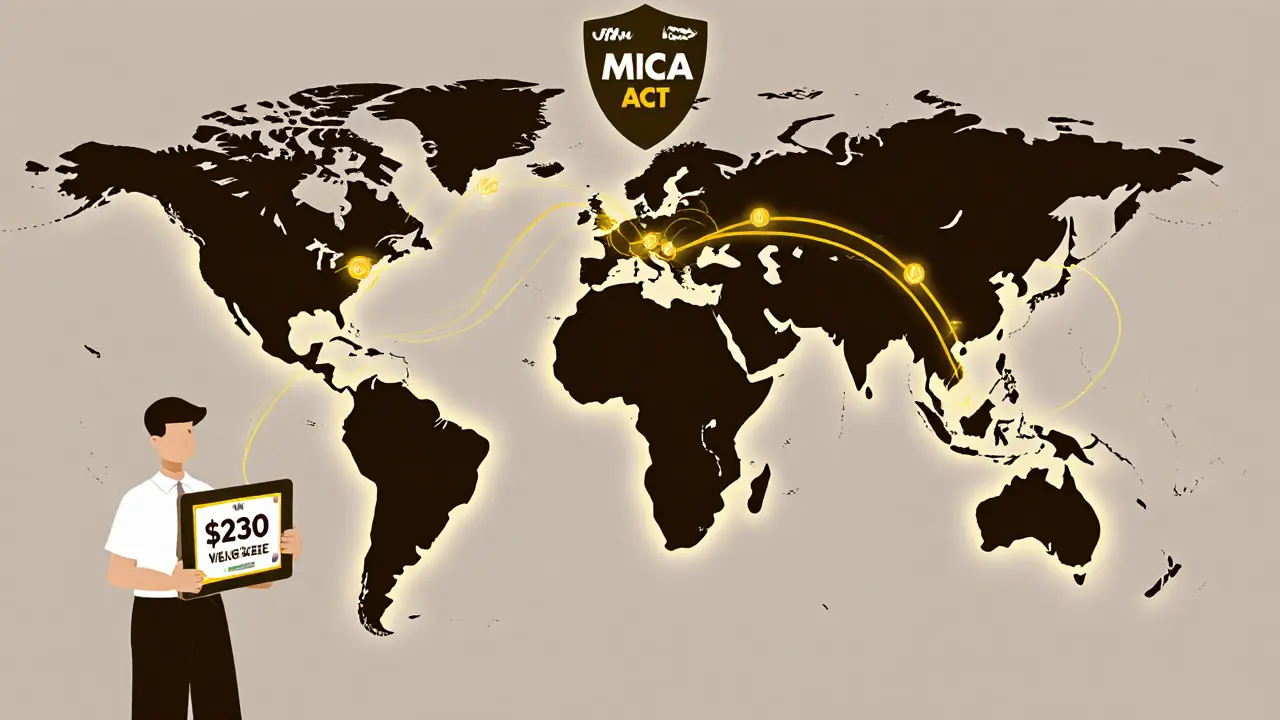
Cross-border Payment Cost Calculator
Your Transfer Details
Payment Comparison
Imagine sending money from New Zealand to Mexico and having it arrive in your cousin’s bank account in under 10 minutes - not days. No hidden fees. No guesswork on exchange rates. That’s not science fiction. It’s happening right now, thanks to crypto-based payment systems that are quietly replacing slow, expensive traditional banking channels.
Traditional cross-border payments still take 2 to 5 business days and cost an average of 6.4% per transaction, according to the World Bank’s 2024 report. That’s $64 on a $1,000 transfer. Meanwhile, crypto alternatives using stablecoins like USDT and USDC settle in minutes, often under 1%, and show real-time exchange rates. For people sending remittances, small businesses paying overseas suppliers, or freelancers getting paid globally, this isn’t just convenient - it’s life-changing.
How stablecoins cut through the banking mess
The secret isn’t Bitcoin. It’s stablecoins - digital coins pegged 1:1 to real money like the U.S. dollar, euro, or peso. They’re not speculative. They’re digital cash. When you send $500 from Germany to Brazil, you don’t send euros directly. You convert them to USDC, send it over the Ethereum or Solana blockchain, and the recipient’s local partner converts it to Brazilian reais. All of it happens in under 10 minutes.
This is called the “stablecoin sandwich.” You start with fiat, turn it into a stablecoin, send it across the blockchain, then turn it back into local currency. No SWIFT network. No intermediary banks. No delays. The whole process is automated through APIs - software connections between crypto platforms and local banks.
By mid-2025, the global stablecoin market hit $210 billion in value, up from $105 billion just 18 months earlier. That’s not just crypto enthusiasts. It’s companies like PayPal, Ripple, and even banks using these systems to move money faster and cheaper.
Speed and cost: The numbers don’t lie
Let’s compare:
- Traditional banking: 3.7 days average settlement time, 6.4% average fee, FX spreads up to 2.8%
- Stablecoin payments: 8.2 minutes average settlement time, 0.5-1.2% fee, FX spreads as low as 0.35%
McKinsey’s July 2025 analysis found stablecoin transfers have a 98.7% success rate for same-day delivery to bank accounts. Traditional SWIFT transfers? Only 63.2%. In corridors like the U.S. to Mexico, where remittances are huge, stablecoin-based transfers now make up 22% of all inbound payments, according to the Bank of Mexico.
One business owner in Wellington told me he used to wait 4 days for payments from clients in India. He lost cash flow. Now he uses USDC. He gets paid in 7 minutes. His FX savings? 2.3% per transaction. That’s $230 saved on every $10,000.

Who’s using this - and where?
Adoption isn’t equal. Latin America leads. Mexico, Brazil, and Colombia are seeing explosive growth because their traditional banking systems are slow and expensive. Asia-Pacific follows closely, with 18.3% of cross-border payments now using crypto tools. In contrast, North America and Europe are slower - but catching up fast.
Who’s driving this?
- Remittance companies: 47% adoption rate. They’re the biggest users.
- Fintechs and payment processors: 38%. Companies like BVNK and OpenPayd build the bridges between crypto and local banks.
- Enterprises: 62% use it for treasury management - paying suppliers, managing foreign cash.
PayPal now lets over 12,000 merchants accept crypto payments and convert them instantly to local currency. That’s not a niche feature. That’s core infrastructure.
The catch: Liquidity and regulation
It’s not perfect. The biggest problem? Last-mile liquidity. If your recipient’s country doesn’t have a reliable off-ramp partner - someone who can turn stablecoins into local cash - the transfer fails.
For example: Sending USD to Nigerian Naira has a 68.4% success rate. Sending USD to Mexican Peso? 99.1%. Why? Because there are dozens of licensed liquidity providers in Mexico. Fewer in Nigeria.
And then there’s regulation. As of June 2025, 37 countries have different rules for stablecoins. Some ban them. Some require licenses. The EU’s MiCA law and the U.S. GENIUS Act are starting to bring order, but it’s still a patchwork.
Also, if the crypto market crashes - like it did in March 2024 - blockchain networks can get congested. Settlement times jump from 10 minutes to 25-30. Not ideal, but rare.

Getting started: What you need to know
If you’re a small business or freelancer thinking about switching:
- Choose a regulated provider. Look for platforms like BVNK, Coinbase Commerce, or OpenPayd - they’re audited and compliant.
- Set up accounts with on-ramp and off-ramp partners. You need one in your country and one in the recipient’s country.
- Start small. Test a $500 transfer before scaling.
- Track your FX savings. Most providers show real-time rates - compare them to your bank’s.
Integration takes 2-3 weeks if you already use APIs. If you’re still on old banking software? Plan for 6-8 weeks. You’ll need someone who understands blockchain basics and API connections. Most businesses hire one technical person or outsource to a fintech partner.
What’s next? The road to 2027
The Federal Reserve is testing stablecoin integration into its FedNow real-time payment system - launching by end of 2025. The European Central Bank is preparing its own digital euro for wholesale payments. Even JPMorgan, once skeptical, now calls stablecoins a “permanent fixture.”
By 2027, McKinsey predicts stablecoins could handle 20-25% of all cross-border payments. That’s up from 12.7% today. The money’s moving. The infrastructure’s here. The question isn’t if - it’s when you’ll use it.
Traditional banking isn’t disappearing. But for anyone who needs speed, transparency, and lower costs - it’s no longer the only option. The system’s broken. Crypto alternatives aren’t just fixing it. They’re rewriting the rules.
Leo Lanham
6 11 25 / 05:11 AMBro. This is literally the future. I sent $200 to my cousin in Mexico last week and it was there before my coffee got cold. Banks are dinosaurs with abacuses.
Brian Webb
8 11 25 / 04:08 AMI’ve been using USDC for freelance payments from clients in Colombia. The difference in speed and cost is insane. I used to lose like $50 per $1k in fees and delays. Now it’s under $10 and instant. Life changed.
Whitney Fleras
8 11 25 / 12:19 PMIt’s wild how much this matters for people who rely on remittances. My mom sends money to her sister in Guatemala every month. She never understood why it took so long or cost so much. Now she just taps her phone. No more stress.
Colin Byrne
9 11 25 / 16:49 PMLet’s not pretend this is some revolutionary breakthrough. Stablecoins are just digital IOUs backed by opaque entities with no real accountability. The blockchain doesn’t magically eliminate counterparty risk-it just obscures it behind code. And let’s not forget the energy consumption, the volatility of liquidity providers, and the fact that 90% of these ‘success rates’ are cherry-picked from high-liquidity corridors. This isn’t progress. It’s financial theater.
Megan Peeples
11 11 25 / 07:49 AMWow. Just... wow. You actually believe this? Who even uses this? I mean, really? The fact that you’re not terrified of unregulated digital assets replacing sovereign currencies is honestly alarming. This is how economies collapse. Mark my words.
Sarah Scheerlinck
13 11 25 / 03:09 AMAs someone who’s worked with small businesses in rural Mexico, I’ve seen firsthand how this tech is changing lives. One woman I met runs a bakery and gets paid by U.S. customers via USDC. She used to wait three weeks for checks to clear. Now she buys flour the same day. No more missed payments. No more loans. Just... freedom.
Evan Koehne
14 11 25 / 03:45 AMOh cool, so now we’re replacing the slow, expensive banking system with... a slow, expensive blockchain system that’s only fast if you live in a country with enough venture capital to build infrastructure? Brilliant. Next up: paying for tacos with NFTs.
Jeana Albert
14 11 25 / 13:18 PMTHIS IS A SCAM. YOU’RE ALL BEING MANIPULATED. THE GOVERNMENT ISN’T TELLING YOU THE TRUTH. STABLECOINS ARE A TOOL FOR ELITES TO STEAL YOUR MONEY. I SAW A GUY ON YOUTUBE WHO LOST $40K BECAUSE HIS WALLET GOT HACKED. YOU THINK YOU’RE SMART? YOU’RE JUST A SHEEP.
Diana Smarandache
15 11 25 / 04:45 AMThe regulatory uncertainty remains the most critical obstacle. Without clear legal frameworks, adoption will remain fragmented. The EU’s MiCA is a step forward, but the U.S. still operates under a patchwork of state-level regulations that deter institutional participation. This is not a technology problem-it is a governance failure.
Arjun Ullas
15 11 25 / 10:23 AMAs a fintech engineer in Mumbai, I can confirm that liquidity gaps are real. We integrated a stablecoin gateway for clients in Kenya, but the off-ramp partner collapsed last month. No Naira conversion, no payout. We lost two clients. This tech is powerful, but it’s only as strong as its weakest link.
Steven Lam
16 11 25 / 21:13 PMwhy do people even care about fees i mean its just money right like if you want to send cash just use western union stop overcomplicating everything
Noah Roelofsn
17 11 25 / 20:54 PMWhat’s fascinating isn’t just the cost savings-it’s the composability. Imagine a small business in Guatemala using USDC to pay a supplier in Vietnam, who then uses it to buy raw materials from a factory in Indonesia-all without a single bank intermediary. This isn’t just faster money. It’s the birth of a new global economic layer, built on trustless, programmable value. We’re not just cutting out middlemen-we’re redefining how value moves across borders.
Sierra Rustami
18 11 25 / 05:34 AMAmerica built the dollar. We don’t need some crypto gimmick to send money overseas. This is just another way for tech bros to pretend they’re smarter than the system that made them rich.
Glen Meyer
18 11 25 / 10:09 AMThey’re gonna come for your crypto next. Mark my words. This is how they start taking away your freedom. First stablecoins, then your bank account, then your right to cash. Wake up.
Christopher Evans
20 11 25 / 04:42 AMThe data presented is compelling, particularly the 98.7% success rate for same-day delivery. However, it should be noted that these figures are derived from controlled environments and may not reflect real-world variability in emerging markets with unstable internet infrastructure or limited access to compliant on-ramp services.
Ryan McCarthy
21 11 25 / 00:00 AMIt’s not about picking sides-banks or crypto. It’s about giving people better options. I used to think this was just for techies. Then my neighbor, a single mom working two jobs, told me she finally got paid on time for her remote design gigs. That’s the real win. Not the tech. The people.
Abelard Rocker
21 11 25 / 07:05 AMLet’s be real-this whole thing is a Ponzi scheme dressed up as innovation. The stablecoin market exploded because investors were chasing yield, not because it’s actually useful. And now everyone’s pretending it’s the future? Please. The same people who sold you Bitcoin at $20k are now selling you USDC at $1.0001. It’s the same script, different script. The only thing that’s changed is the buzzwords. ‘DeFi’ became ‘stablecoins’ became ‘CBDCs’-it’s all just financial snake oil with a blockchain logo on it. And don’t even get me started on the environmental cost. Every transaction burns more energy than your toaster uses in a week. Wake up. This isn’t progress-it’s peak capitalism hallucination.
Hope Aubrey
21 11 25 / 10:21 AMLet’s be honest-this is just Wall Street’s way of laundering crypto into the mainstream. MiCA? GENIUS Act? Sounds like PR spin. They want you to think this is ‘regulated’ when really, it’s just another hedge fund playing with your money under a new name. And don’t even get me started on the tax implications. The IRS is already auditing these transactions. You think you’re saving money? You’re just setting yourself up for a nightmare audit.